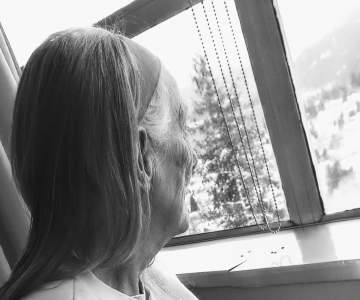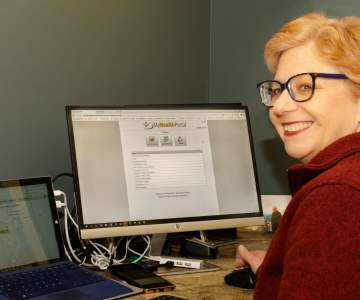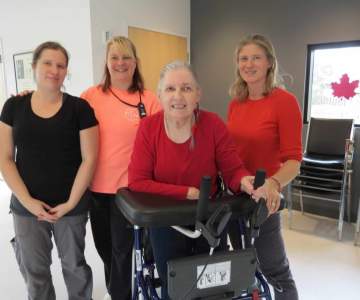Breadcrumb
Explore Stories
3 Minute Read
Health & Wellness
In the film "Cast Away," Tom Hanks plays a business executive who crash-lands on a deserted island. He copes with years of social isolation in part by befriending a volleyball, which he names Wilson. Wilson becomes someone to confide in, to tell jokes to, and to even argue with. When Wilson is swept away in an ocean current, Hanks is devastated at the loss.
Many of us have had fantasies about living alone on a tropical island, far from the chaos and pressure of modern life. But research shows we would fare just as poorly as Tom Hanks in such isolated conditions.
Social isolation is a negative experience that includes painful feelings of not belonging and not feeling connected to others. It happens because there is a difference between the amount and quality of social relationships we want, and those that we actually have.
It’s a growing problem in
Canada and one that’s particularly an issue in many communities in the Interior
Health region.
Some researchers refer to the socially isolated as hidden citizens because it can be difficult to identify those who are experiencing it.
“Although people of any age
can be socially isolated, seniors tend to be more
at risk because many live alone, and, as people age, they may have smaller
social networks and experience mobility issues,” says Shannon Paul-Jost, Gerontology
Clinical Nurse Specialist.
These factors can be compounded for those living in rural or remote communities, where travel to other communities can be challenging and winter months can leave many feeling additionally isolated.
Health risks
Research has found that social isolation is associated with a number of health risks, including:
increased chance of premature deathlower general well-beingdepressiondisability from chronic diseasespoor mental healthreduced quality of lifecaregiver burdenpoor general health
Making improvements
Health and social organizations are working to improve social connections for these hidden citizens.
One such effort is a project led by the non-profit Kalein Centre in Nelson. CLICK! is an intergenerational program that connects high-school students and older adults in the Nelson community. Participants in the program discuss a variety of topics, including social isolation, resiliency and gratitude, and then take photos in their community that capture what they’ve learned.
“CLICK is the sound of a
camera shutter releasing. It’s also that warm feeling you get when people truly
connect. That’s what people are often missing in their lives in an age where
communication technology can often isolate,” says Mike Stolte, Director of
Dialogue and Education at Kalein.
Vicki Huva, a participant in CLICK!, says the program is a step in the right direction of creating a stronger connection between youth and elders in the community.
“What many people don’t realize is that you can become invisible as you age,” says Vicki. “That lack of connection hurts. Not everyone is fortunate enough to have that connection in their lives. People feel better when they feel they belong and these programs help to break down some of those barriers”.
2 Minute Read
Research & Innovation
Estamont resident Diane Edlund says online access to her personal health information is an important step in creating a partnership between health-care providers and patients.
As a patient partner with the Patient Voices Network, Diane provides a valuable perspective to health organizations on how they can improve the quality of care in B.C.
Diane is one of more than 86,000
people who have signed up for MyHealthPortal, an online tool that provides Interior Health patients with secure
24-hour access to their personal health information from a home computer,
tablet or smartphone.
"Access to my health information makes me feel more in control. I feel like I can take part in my care".“Having the same health-care
information as my doctor allows me to ask informed questions and share in the
decision-making. In the past, only clinicians had access to this type of
information; but I think it’s past time we move towards a system where patients
and care providers are seen as equal, valued and respected partners in care,”
says Diane. “I think my lived experience (health, perspectives and unique needs)
is just as important as the health-care provider’s years of education and
clinical experience. We need both sides for good decision-making.”
"It puts me in the driver’s seat of my health care". “Digital tools like MyHealthPortal allow me to
share important information with others in my circle of care. It’s particularly
helpful when moving from hospital back into the community so I can share results and reports and make
sure information doesn’t slip through the cracks.”
For more information and to
sign up, visit MyHealthPortal.
2 Minute Read
Health & Wellness
Walking around your neighborhood or local shops at this time of year, there is a constant reminder that the holidays are a time of happiness and celebration with family and friends.
But if you are grieving the death of a loved one or have experienced another type of loss, the holidays can often magnify that sense of grief.
If the idea of getting to the New Year feels like a struggle, here are some ideas to help.
Be honest with yourself about what you can handle. You might welcome the distraction of holiday decorating and preparation. Or you might not feel up to doing everything you usually do. Give yourself some grace. Social events may be more draining than usual. It's okay not to accept every invitation; don't let others make you feel obligated. If you're attending an event, try to take your own transportation so you can leave when you're ready.
Keep some old traditions, and make new ones, too. Continuing a tradition you shared with a loved one who's gone can make you feel closer, even if it is bittersweet. There can also be comfort in creating a new tradition to honour their memory – lighting a candle, creating a memory box or quilt, putting out a new special ornament, or engaging in a meal or activity that your loved one enjoyed while sharing memories, for example.
Remember that people grieve differently. It's not uncommon for people to have a sense of guilt if they catch themselves feeling happiness or joy while they're grieving – or resenting others for doing so. But grief has no rules or timetable.
Be kind to yourself. With grief, you may be fine in the morning, but by the afternoon or the evening you may feel differently – and that's normal. Don't worry if you can't or don't want to do as much you usually do. The holidays can be draining in the best of times, and grief is exhausting. Give yourself a break.
Connect with others who might understand. There can be comfort in talking with others who understand what you are going through and can relate to how challenging the holidays can be.
There are also some excellent resources online that can help. Visit virtualhospice.ca for resources and information.
The care team at Hospice House Kelowna provides people with a place to live, find comfort, and connect. Hospice House is a part of Interior Health’s Hospice Palliative Care Program.
2 Minute Read
Community & Culture
In the aftermath of the 2017 terrorist attack in Manchester, United Kingdom, something unexpected happened. The community gathered to honour the dead with a spontaneous rendition of Don’t Look Back in Anger by the local band Oasis.
When grief renders words inadequate, music can sometimes provide an outlet for the emotions associated with death and dying.
Suzanne Miller has been singing for those near death for the last three years. She is part of a threshold choir in Nelson, B.C.
The threshold choir provides comfort to those at the thresholds of living and dying. With gentle voices and songs, the singers provide a calm and kind presence at the bedside of those who are near death. Over the years, Suzanne has found this singing to be soothing and reassuring to clients, family, and caregivers alike.
"People are drawn to the threshold choir for many reasons. Some experience 'the shiver' when hearing about the choir’s purpose or their music. Others join after caring for a dying person and realizing how humming, singing, or playing music is part of how we soothe each other," says Suzanne.
The bedside singers come from all walks of life.
“A few of us are musicians; most are not,” says Suzanne. "We learn to carry our parts and blend our voices, some by reading music and others learning solely by ear. Some have a religious or spiritual background, while others are staunch atheists. Many have focused on home-based work and volunteering and have a connection to hospice work.
"As threshold choir singers, the most important things we share are a repertoire of beautiful, meaningful, and soothing songs and a desire to provide comfort and peace at a significant and challenging stage of life.”
2 Minute Read
Health & Wellness
The global climate is changing. On average, the temperature of the earth is rising. This is causing more extreme weather events such as the droughts, fires and floods that many of our communities have experienced this year. These changes affect natural and human environments (air quality, clean water and food sources) and also can have negative effects on our health.
The impacts on health from climate change are varied and will depend on where you live. They can include respiratory diseases, heart disease, heat-related illnesses, mental illness, malnutrition, infections and other illnesses. There are a number of things you can do to protect your health from issues related to climate change:
Air quality: Check the Air Quality Health Index for your area. If it is poor, limit your outdoor activity and follow the other guidelines provided.
Sun, heat and extreme temperatures: Stay covered, use sunscreen, stay hydrated, and watch for signs of heat-related illness during extreme heat events. Never leave children or pets unattended in the car.
Food and water safety: Be aware of food recalls and boil water advisories in your area. This is important not just for drinking, but also food preparation, teeth brushing, etc.
Insects and disease: Learn more about disease-carrying insect threats in your area (e.g. Lyme disease, West Nile virus) and take precautions.
Fires, floods and other emergencies: In preparation for environmental emergencies, put together an emergency kit and evacuation plan. See Government of Canada’s Get Prepared website for tips.
Are you ready to be more proactive? You can limit the negative effects from climate change by reducing your carbon footprint or personal and workplace greenhouse gas (GHG) emissions. Here are a few things that can make a big difference:
Consider “greening" your commute: try walking, cycling, carpooling or taking transit – it doesn’t have to be every day, but using alternate transportation even once in a while can make a difference.
Reduce your energy use: switch off your computer, lights and other electronics when not in use.
Waste less – want less: reduce what you use, re-use items and re-cycle.
Go local: whenever possible buy local foods and local goods.
When you reduce your personal GHG emissions you’ll be helping to improve air and water quality in the short term. Over the long term, you’ll be helping to secure our water and food resources, reduce weather and temperature extremes, and help curb the spread of disease carrying insects. All of which will improve our health.
2 Minute Read
Health & Wellness
I’m already planning what I want to cook for the December holidays. I’m thinking of a dinner that’s a little less traditional this year and I'm looking at lemon risotto and stuffed squash recipes. I get excited about the holidays every year. For some reason cooking for celebrations is a completely different experience for me than the Monday to Friday grind of just getting a meal on the table.
As I was flipping through my cookbooks, my mind was drifting to all of the things that I take for granted and that I should give thanks for; things like being healthy and being able to afford the groceries for this meal.
Times are tough right now. More people are using food banks each year. I've been thinking about how difficult it must be to make a special meal when you're struggling to make ends meet.
People who don't have enough money to buy high-quality food are sometimes called "food insecure." Research shows that having enough nutritious food to eat is important to your health. Those who don't are more at risk of many health conditions including diabetes, heart disease, hypertension, back problems, and poor mental health. Kids with food insecurity have a higher risk of childhood mental health problems, asthma, and depression.
But why? Shouldn’t it be those folks planning rich holiday feasts who have a greater chance of heart disease? It turns out that it’s not that simple.
Not surprisingly, people who are able to buy healthy food are also more likely to have well-paid work, live in good neighbourhoods and afford a fitness pass. Living on a low income, having an unhealthy work environment, and paying a lot for housing, childcare and transportation are stresses that contribute to poor health. On top of all that, unhealthy, highly processed food is usually cheap, while fresh vegetables and fruit can be expensive.
It’s a problem with no easy fix. The good news is that there are many community organizations and local governments that are working to tackle these complicated problems, and Interior Health’s Healthy Communities Program is working alongside many of them.
2 Minute Read
Research & Innovation
The little things were agony, says Gary Gierlichs.
“Little things, like putting your socks on or putting your leg in the car,” he says. “I deteriorated pretty fast, which was tough for an active person like me. Hip replacement changed my life—I can’t say enough about it.”
In 2018, Dr. Tim Bell and his surgical team performed a hip replacement on Gary at Penticton Regional Hospital using a relatively new procedure for Interior Health called the direct anterior approach. This approach allows the surgeon to replace the hip without cutting through muscle and tendon. As a result, patients like Gary experience less pain and are up and moving sooner, often on the same day as the surgery.
“I was thrilled when Dr. Bell told me I could play pickleball at seven and a half weeks after my surgery,” says Gary. “And I did—very gingerly, of course."
Dr. Bell is thrilled with the difference this procedure has made for his patients.
“What’s most enjoyable for me is seeing patients accomplish tasks after their surgery that they’ve been unable to do because of debilitating pain,” says Dr. Bell, who has now performed hundreds of these surgeries.
The direct anterior approach for hip replacement also adopts many of the elements of Enhanced Recovery After Surgery (ERAS). ERAS is an area of focus across Interior Health and uses evidence to minimize the stress of surgery and return the patient to their regular activity sooner.
For example, “drinking clear fluids close to the time of surgery gives the body energy to heal,” says Andrea Lindsay, a project manager for surgical initiatives at Penticton Regional Hospital. "Using narcotic and non-narcotic pain medications can also reduce or prevent nausea and delirium. And having the patient up and moving helps reduce the risk of muscle loss and the development of blood clots.
“If patients and their families are informed and prepared, they have less anxiety and a better experience.”
ERAS also includes lifestyle changes prior to surgery, for example, diet changes to reduce anemia, reducing smoking to reduce pneumonia risk, and strengthening the upper body in order to get in and out of a chair more easily.
“Hip replacement is still a major surgery, so it’s expected that patients will experience some level of pain. However, following some of the preparations of ERAS can reduce complications after surgery and shorten the time the patient needs to stay in hospital,” says Andrea.
And Gary? He’s now enjoying more activity than he has in years. Following his recovery period, Gary went on a holiday to Mexico, played pickleball three or four times a week, and rode his e-bike 60 to 70 kilometres a day.
2 Minute Read
Community & Culture
Stigma. It’s a word used to describe shame and fear of judgment.
It’s also the No. 1 barrier people with substance use disorders cite for not seeking help. And if you thought health-care providers are somehow immune and don’t carry prejudices, you would be wrong.
Like most health-care workers, RN Shari Smith* has dedicated her life to caring for people. Having spent years in critical care, she has seen the results of teen drinking, drug use and overdose. But she never thought it would happen to her family.
“I was so convinced in my mind that it could never be me,” the IH nurse says.
Her son had never had an easy time. He was dogged by health issues, struggled in school, and was labeled a “trouble-maker” from an early age. Still, he was an active kid who loved sports and had many friends.
“Then he had a car accident, and slowly drifted into drug use. Then he drifted in and out of the house. Then he was in and out of jail,” Shari says.
Finally, one warm summer evening after 10 months of abstaining from drugs, he overdosed while his family slept, thinking he was safe because he was with them at home.
“He’d been doing so well. I guess he wanted to celebrate and just do a bit. But it was a lethal dose of fentanyl.”
After the loss of her son, it took Shari a while to get back to work. She was acutely aware of the attitudes of those working at her side and words that stung like salt in a wound.
“We see overdoses every day, and you hear all kinds of comments. We had a young kid that had overdosed and the woman beside me was saying ‘what a waste of money – their parents should be given the bill because it’s their screw-up.’ Those comments are everywhere. Even from the nicest people. It’s so removed from them, they have no concept that it could happen to them too.”
When choosing to put a stop to stigma, words count. To learn more about using respectful language visit Toward the Heart.
*Names changed to protect privacy.
2 Minute Read
Community & Culture
At 66 years of age, Carolyn inspires those who know her. Born with cerebral palsy, Carolyn lived with her parents until their poor health made it necessary for them to move into a long-term care home three years ago. For the first time in her life, Carolyn needed to figure out the basics of living on her own. She learned how to cook, pay bills and make the 4.5 kilometre journey from her home to her parents' home on her power wheelchair. She makes this journey once a week to visit her parents, to get some help with her weekly bath, and help the activity team run their regular bingo game. Last winter, as the weather got colder, this routine started to become more difficult. Carolyn’s wheelchair couldn’t handle the long trip in the snow, and she didn’t have the money to use a transportation service anymore. “I’d been watching Carolyn for several months and was so impressed with her determination,” says Coreena Esser, a recreational therapy assistant at Interior Health's Adult Day Services program in Golden. “When I realized what a struggle she was having, I encouraged her to join the Adult Day program, so she could be picked up from her home and brought over for her bath, lunch and a visit with her family." Never one to leave well-enough alone, Coreena asked to visit Carolyn’s home later in the year to make sure she had the support she needed. “I noticed right away that the way Carolyn transferred herself from her wheelchair to the couch was very risky,” says Coreena. “I knew her knees wouldn’t be able to handle that motion for very long and I asked if she’d be willing to meet with our physiotherapist to see how we could make things better for her.” Through some trial and error with different walkers, and lots of hard work, Carolyn has a safe and effective way of transferring in and out of her wheelchair. Her work with the physiotherapy and rehab team had other benefits. Carolyn started using a stationary bike. As her strength improved, she was able to start walking for the first time in 15 years. “I’m so proud of Carolyn and all that she’s accomplished,” says Coreena. “She’s shown me that it’s never too late to learn something new.”
-
Load More
Showing 675 of 679
STAY CONNECTED
Receive news and alert posts, and Stories@IH blog posts, right to your inbox!









